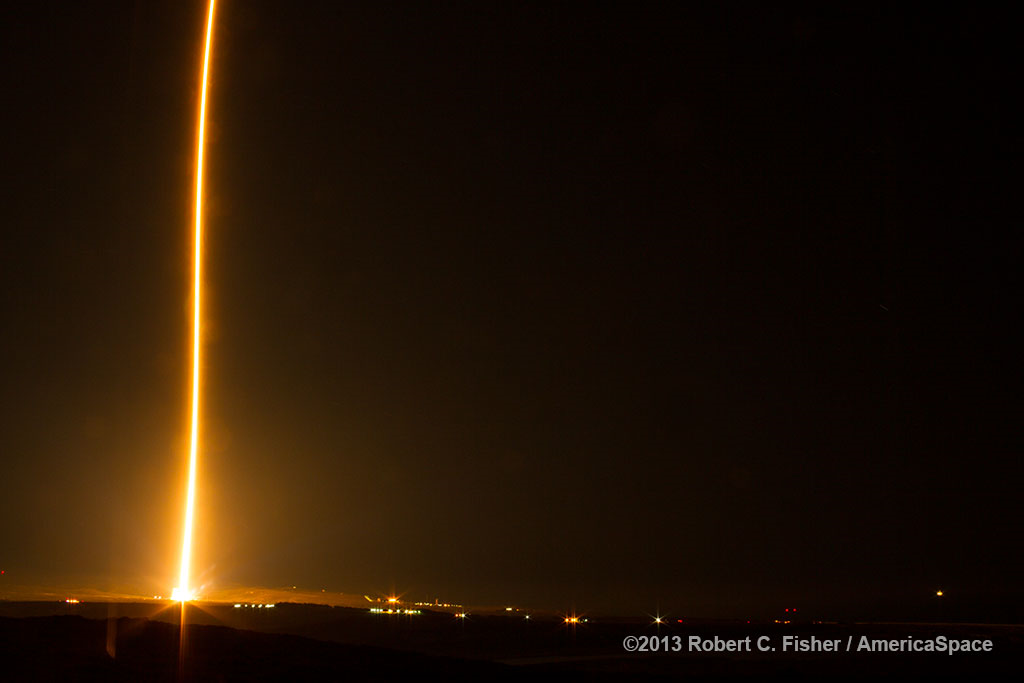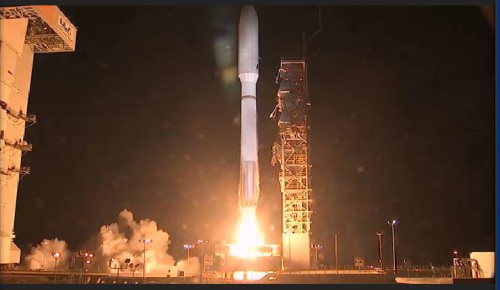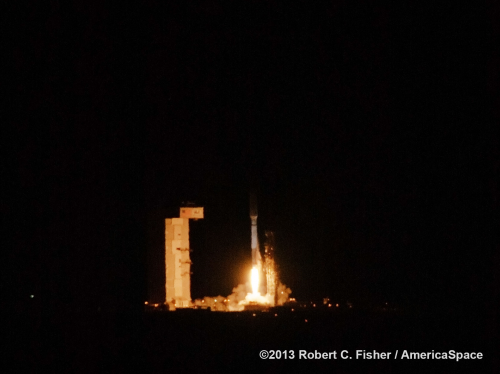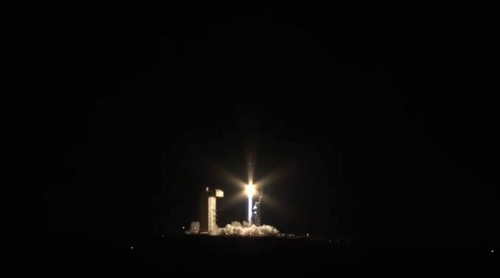
Cloaked in secrecy and shrouded by the hours of darkness, United Launch Alliance (ULA) has successfully launched a payload into orbit for the National Reconnaissance Office (NRO), describing the NROL-39 mission as being “in support of national defense.” The Atlas V rocket, which flew in its “501” configuration—equipped with a 17.7-foot-diameter (5.4-meter) payload fairing, no strap-on boosters, and a single-engine Centaur upper stage—lifted off at 11:14:30 p.m. PST Thursday, 5 December (2:14:30 a.m. EST Friday, 6 December) from Space Launch Complex (SLC)-3 at Vandenberg Air Force Base, Calif. Although the precise nature of NROL-39 remains classified, it is widely believed to be the third member of the Future Imagery Architecture (FIA) constellation of radar-reconnaissance satellites, located in circular, 680-mile-high (1,100-km) orbits.
Following a smooth rollout of the 196-foot-tall (60-meter) Atlas V out to SLC-3, a flurry of activity ensued to establish pad connections, perform pneumatic and other checks, and verify the performance of the vehicle’s flight control systems. Status checks continued until late into the countdown, with liftoff moved back by about a minute from the original 11:13 p.m. target. Weather conditions at Vandenberg appeared iffy at the start of the day, with AmericaSpace’s Launch Tracker noting at 9:46 a.m. PST that “the recommendation was to attempt the launch today,” but that “the weather officer is only predicting a 20-percent chance of favorable weather at launch time,” with major concerns centering on forecasted temperatures in the 35-40 Fahrenheit range at launch time. As the afternoon wore on, conditions steadily improved and were recorded as 60-percent favorable.

Accordingly, the six-hour, 20-minute countdown got underway at 4:53 p.m. EST with the activation of the first flight control systems. This was followed by the start-up of ground command control and communications systems, verifying a good link between the Launch Control Center and the Atlas, and by 6 p.m. the preparations for fueling were underway, with inert gaseous nitrogen used to purge and condition the propellant lines. Two hours before the scheduled liftoff, at 9:13 p.m., the Launch Director polled the team and received a “Go” for tanking, with promptly got underway with the chilling-down and pressurization of the on-board tanks and fuel lines. A final weather briefing and consultations among launch personnel produced a slightly adjusted launch time of 11:14:30 p.m.
By this stage, weather conditions had improved and the Air Force revised its forecast to announce a 0-percent chance of violations, with ground winds at 7 knots and high-level winds from the northeast. At T-4 minutes, following a unanimous “Go for Launch” from all stations, the countdown emerged from its final planned hold. The Atlas’ propellant tanks were verified to be at their proper flight pressures, and the Flight Termination System (FTS)—tasked with destroying the vehicle in the event of a major accident during ascent—was placed onto internal power and armed.Two-and-a-half seconds ahead of liftoff, the first stage’s Russian-built RD-180 engine—with a propulsive yield of 860,000 pounds (390,000 kg)—roared to life and climb-out from SLC-3 occurred at T+1.1 seconds. Shortly after clearing the tower, the Atlas executed a combined pitch, roll, and yaw program maneuver, which positioned it onto the proper flight azimuth for the insertion of the classified NROL-39 payload into orbit. Eighty-three seconds into the flight, with the RD-180 still burning hot and hard, the vehicle burst through the sound barrier. At around this time, the maximum aerodynamic stresses were experienced throughout the Atlas’ airframe.
Three-and-a-half minutes after launch, the huge, two-piece payload fairing encapsulating NROL-39 was jettisoned, exposing it to the near-vacuum of space for the first time. Thursday night’s launch was only the fifth time in Atlas V history that the vehicle has flown in its 501 configuration, having previously supported three flights of the U.S. Air Force’s Orbital Test Vehicle (OTV) mini-shuttle in April 2010, March 2011, and December 2012, as well as the NROL-41 mission—thought to be the first FIA satellite—in September 2010. The first stage engine provided the impetus for the first five minutes of the Atlas V’s ascent, and shortly after being jettisoned the restartable Centaur upper stage—powered by the RL-10 engine, with a total thrust of 25,000 pounds (11,340 kg) in a vacuum—picked up the baton to push NROL-39 into orbit.

In readiness for Thursday’s launch, the booster and payload hardware have been delivered quite literally from points all over the United States and elsewhere in the world. From ULA’s own headquarters in Denver, Colo., to the launch site at Vandenberg Air Force Base, Calif., and from the fabrication of the Centaur upper stage fuel tank in San Diego, to its final assembly in Decatur, Ala., and from the manufacturing of the RD-180 first-stage engine in Khimki, Russia, to the construction of the Atlas V payload fairing in Zurich, Switzerland, this most secretive of launches boasts the distinct flavour of many states and many nations. All of those elements converged on Vandenberg to be blasted into orbit.With the exception of its name, little of substance is known about NROL-39, and ULA has noted only that its purpose is “in support of national defense.” This mission is the second Atlas to fly from the West Coast in 2013, following February’s launch of the Landsat Data Continuity Mission (LDCM, also known as Landsat-8), and the second Atlas mission in only three weeks, coming hard on the heels of the flight of the Mars Atmosphere and Volatile Evolution (MAVEN) from Cape Canaveral Air Force Station on 18 November. Overall, Thursday’s planned launch will be the 11th flight conducted by ULA this year—from both Vandenberg and the Cape—eight of which have been conducted by the Atlas V and three by the Delta IV. Aside from Landsat-8 and MAVEN, the two rocket families have transported NASA’s latest Tracking and Data Relay Satellite (TDRS-K), two Global Positioning System (GPS) Block IIF satellites, a pair of Wideband Global Satcoms (WGS), a missile early-warning satellite, two military communications satellites, and the classified NROL-65 reconnaissance payload atop the Delta IV Heavy.
In spite of these successes, it has been a troubled year for ULA, with the Delta IV officially grounded since October, due to ongoing investigations into the RL-10B2 upper stage engine. As noted by Mike Killian in a recent AmericaSpace article, the root of the problem can be traced back to a troubled launch in October 2012. Although the Delta successfully delivered its primary payload into orbit, it became apparent that something had gone awry with the performance. An “unexpected data signature” was identified when the Pratt & Whitney-built RL-10B2 experienced a period of reduced thrust. Fortunately, the vehicle’s robust design, flight software, margins, and propellant reserves enabled it to compensate for this difficulty and complete its mission.

In the wake of the anomaly, ULA and U.S. Air Force experts implemented a number of corrective actions, thoroughly inspecting engine systems for damage or the presence of “foreign objects” and recommended in-flight helium purges of critical components and changes to how the RL-10B2 is thermally conditioned during the early stages of ascent. The commonality of the engine to the RL-10A aboard the Atlas V meant that both rockets were grounded in late 2012, although an Atlas V 501 successfully delivered the third mission of the Air Force’s Orbital Test Vehicle (OTV-3) mini-shuttle into orbit in December. Whilst the Air Force continued with Phase II of its investigation into the engine problems, the Delta IV was finally cleared and returned to flight in May 2013.
However, in mid-October, as final preparations were underway for the launch of the GPS IIF-5 payload aboard a Delta IV, a delay was called. “The ongoing Phase II investigation has included extremely detailed characterization and reconstructions of the instrumentation signatures obtained from the October 2012 launch,” explained ULA spokesperson Jessica Rye, “and these have recently resulted in some updated conclusions related to dynamic responses that occurred on the engine system during the first engine-start event.” The time-critical Atlas V launch of the MAVEN spacecraft on its voyage to Mars in mid-November was apparently unaffected by the problems, and according to Spaceflight Now the Delta IV mission is currently scheduled to fly no earlier than 12 December.
It has been speculated that NROL-39 may be the third member of the Boeing-built Future Imagery Architecture (FIA) constellation of radar-reconnaissance satellites, due in part to the apparent retrograde nature of its orbit and the 123-degree inclination already revealed by the Atlas V’s secondary payload operators. The FIA was conceived in 1999 as the successor program to the Lacrosse imaging network, which saw five satellites launched—including one from the space shuttle—between 1988 and 2005. Significant cost and schedule overruns forced John Negroponte, then-Director of National Intelligence, to cancel its optical component in 2005, but the radar element continued under the code name of “Topaz.”
Two FIA satellites have been launched to date: NROL-41 atop an Atlas V 501 in September 2010 and NROL-25 atop a Delta IV Medium+ (5,2) in April 2012, both of which currently reside in circular 680-mile-high (1,100 km) orbits. “This being the second Atlas V 501 launch from Vandenberg,” noted Spaceflight 101 of the impending launch of NROL-39, ”it is very likely that it is carrying the next FIA satellite,” adding that “The 123-degree inclination has been confirmed by the secondary payload operators.” Those secondary payload operators are responsible for 12 CubeSats which will also hitch a ride into space aboard the Atlas V and have been provided by the National Reconnaissance Office and through NASA’s Educational Launch of Nanosatellites (ELaNa) program.
Want to keep up-to-date with all things space? Be sure to “Like” AmericaSpace on Facebook and follow us on Twitter: @AmericaSpace
Missions » NROL »


